
23 minute read
MARS – STILL MAGNIFICENT
MARS STILL MAGNIFICENT
FEATURE JESPER KJØLLER AND RICHARD LUNDGREN PHOTOGRAPHY JESPER KJØLLER, KIRILL EGOROV, KEES BEEMSTER LEVERENZ, OCEAN DISCOVERY AND JULIA GOLOSIY.
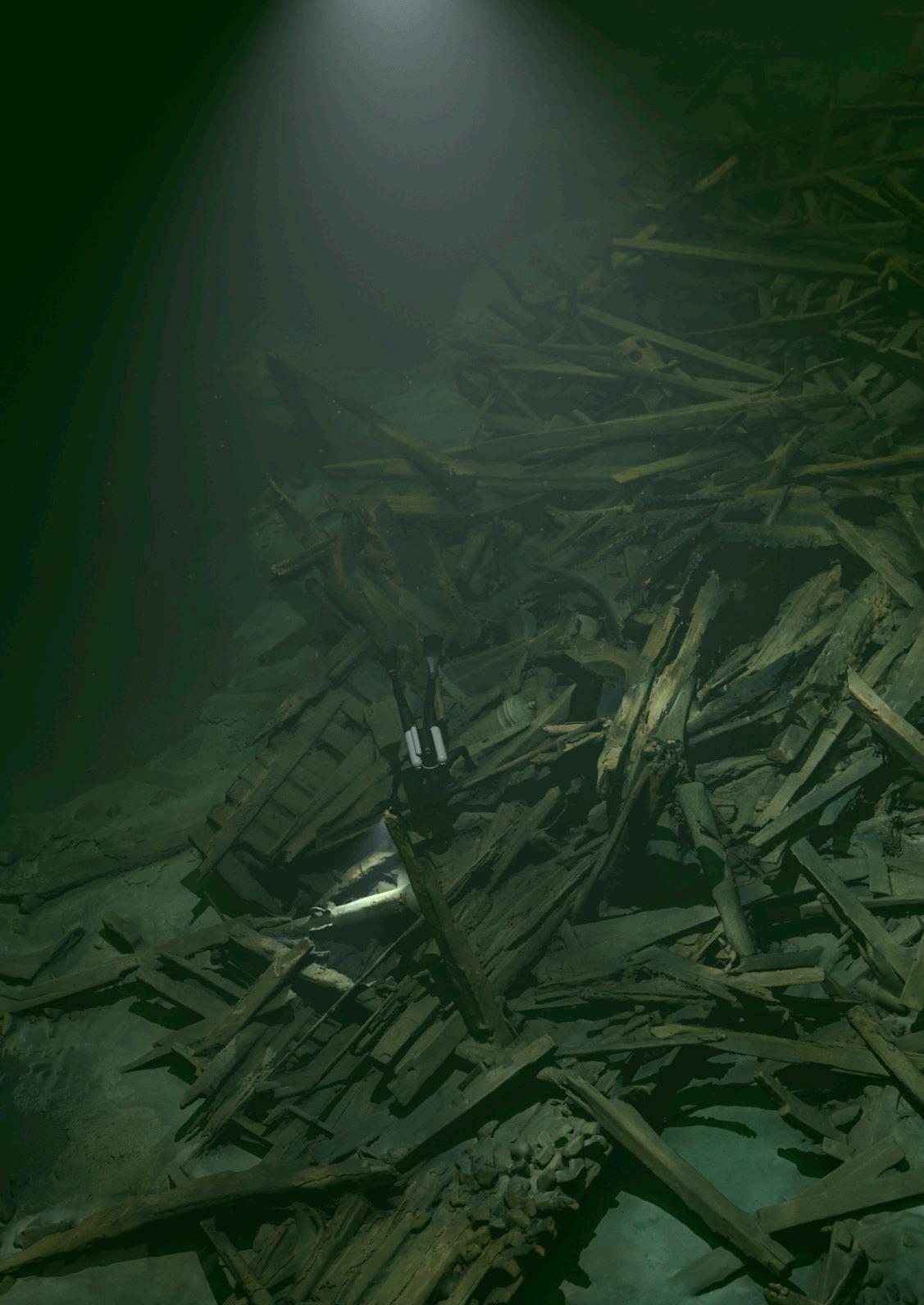

Why is the discovery of the Swedish warship Mars Makalös, which sank in 1564, one of the most important wreck finds in the world? How did a boy’s childhood dream and stubbornness result in the discovery of Mars 447 years after it sank? Through advanced digital archaeological methods, how are technical divers and scientists still exposing Mars’ secrets?



PART 1: 1564 – THE LOSS The smoke from the fire is thickand the stench of gunpowder mixes with reverberations of cries and steel blades striking steel blades. The rumble from muskets and cannons are deafening. The deck of Mars is red with blood and it is hard to get traction on the slippery surface. Brave Swedish sailors and soldiers are fighting for their lives. Wave after wave, they drive the enemy back. It is the 31st of May 1564, and the merciless sea battle rages northeast of Øland in the Baltic Sea.
Mars is now on fire and the air is thick with tangible desperation. It is only a matter of time before the flames reach the gunpowder stores. It is inconceivable to surrender. Only those with noble blood can hope for a pardon from the victors. Ordinary captured soldiers will lose their lives in the cruellest way to deter the enemy. The Danes and their associates, the professional mercenaries from the Hanseatic city of Lübeck, are driven by a burning ambition to capture Mars. It would be a fantastic trophy, so the soldiers don’t care about the political goals of the kings – they just want their share of the treasures of war.
A powerful explosion suddenly shakes the mighty ship. The whole deck seems to rise. Both Swedes, Danes and German mercenaries are now desperately trying to leave Mars, which is sinking rapidly. The water is boiling, and a huge cloud of steam climbs like a giant ghost out of the sea. Mars is no longer to be seen. Back on the surface, debris, mutilated and dying sailors are the only ones left.
COURTSHIP The Swedish King Gustav Vasa’s son, Erik XIV’s is eagerly touring Europe’s royal courts in a quest to find a bride.The Prince is about 30 and he wants to get married.
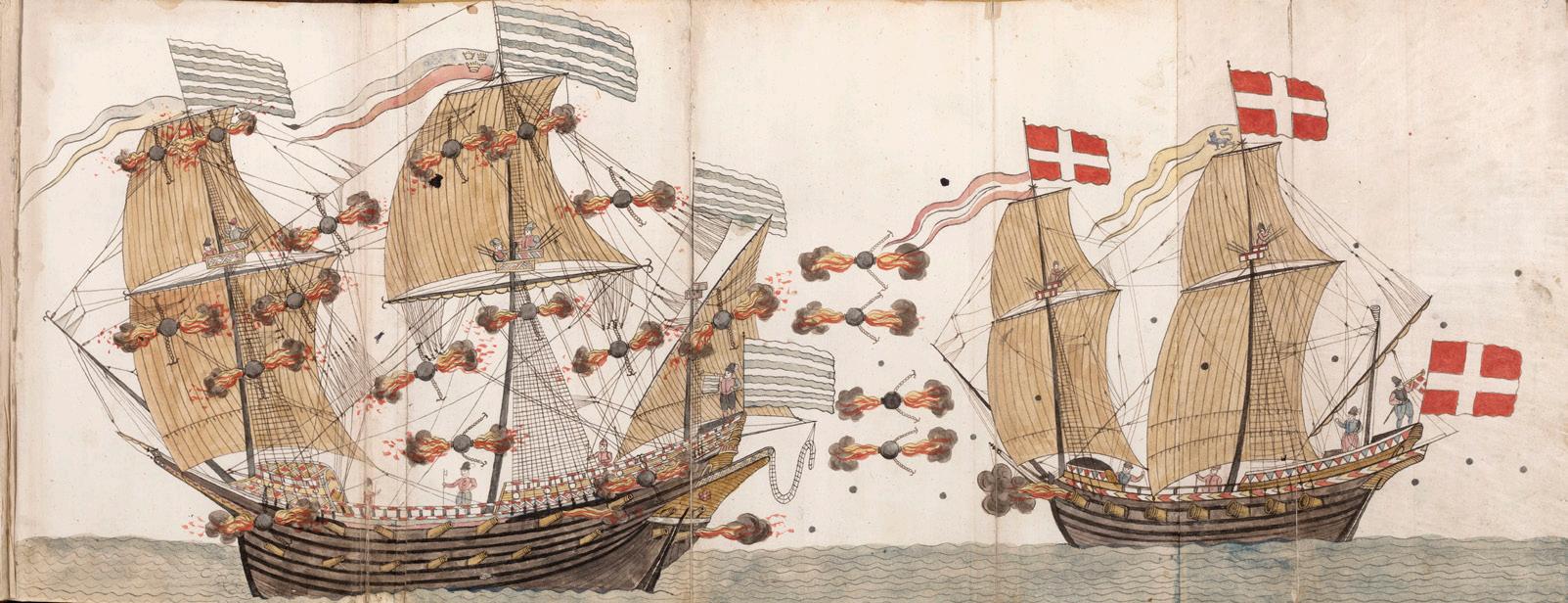
Gustav Vasa has purposefully built a strong fleet to secure Sweden’s trade on the Baltic Sea. Prince Erik often requests these ships as transport on his pursuit to find a suitable bride. It must have been a pretty impressive sight when the Prince of Sweden entered a port, escorted by the Baltic’s most modern fleet.
The Swedish military build-up does not escape the attention of the Danish King Frederik II and the political situation is getting tense. Gustav Vasa takes the initiative to build Mars Makalös. She will be the Baltic’s largest and most capable warship. Her gigantic keel is laid in Björkenäs off the coast of Kalmar, and the ship will be onethird longer than the largest Swedish warship, The Elephant. Mars is to be equipped with 30 percent of the Swedish Navy’s total number of bronze cannons. The exact number of cannons has been forgotten, but it is more than 100 and at least two of them weigh at 42-pounds each, a size that had until now only been used as land artillery. Bronze is a precious metal and it is very expensive to cast these weapons. To the great regret of the clergy, Gustav Vasa commands the impounding of the country’s church bells to be converted into cannons.
King Gustav himself never gets to see Mars completed. He dies in 1560, but with the completion, Erik has Europe’s most modern fleet and he intends to use it.

NEW STRATEGY The situation between Denmark and Sweden has worsened during the 1550s and 60s, and battles at sea have become more common. Erik has sent his admiral Jacob Bagge to deliberately provoke the Danes into conflict –this happens next to Borgholm in Øland. The battle is short and the Swedish victory is crushing. Denmark later responds by occupying Elfsborg’s fortress on the west coast of Sweden without much difficulty. This allows them to bring large troops into Swedish territory. Erik’s situation is beginning to get desperate. The Swedish army, mostly made up of poorly equipped farmers, is no match against the German mercenaries hired by the Danish King. Erik is forced to strike back and he inser ts his fleet led by Admiral Bagge.
On May 30, 1564, the Swedish fleet confronts the Danes off the Tjust archipelago and heads down towards the northern tip of the island. The battle rages on for two days and initially things go well for Bagge and the Swedes. With its mighty artillery, Mars sinks the Danish vessel Lange Bark.
In this time, it was unusual for battle ships to be destroyed only by the opponent’s artillery. The traditional tactic of a sea battle was to inhibit the opponent’s manoeuvrability and kill as many enemies as possible, then board the vessel and take it as a victory trophy. The fact that Lange Bark was shot down, indicates that the Swedes had deployed a new and ground-breaking sea battle strategy. Avoid close combat, but instead use superior artillery force to win the battle.
During the evening afterthe first day’s combat, both fleets retreat into the shelterofdarkness.

DEADLY BATTLE As the day dawns on the 31st of May, the wind has picked up and the Swedish fleet has a hard time keeping their formations. To Admiral Bagge’s regret, the fleet is now split up into smaller groups. The Danes seize the moment and attack the admiral ship Mars. The rest of the Swedish fleet are just spectators while Mars in her solitary dignity, puts up a heroic battle against the entire Danish fleet.
The fight is fierce and desperate.The Danish vessels repeatedly try to get close enough to enter Mars, but they are repeatedly pushed back. Mars’ cannons fire constantly and several Danish vessels are close to collapse. Maybe Mars’ helm was damaged during the battle? Maybe the sails were destroyed? We don’t know, but for some reason several enemy vessels manage to get close to Mars and latch on to her railing. Danish soldiers board Mars and a desperate final battle ends in a powerful explosion that sinks Mars.
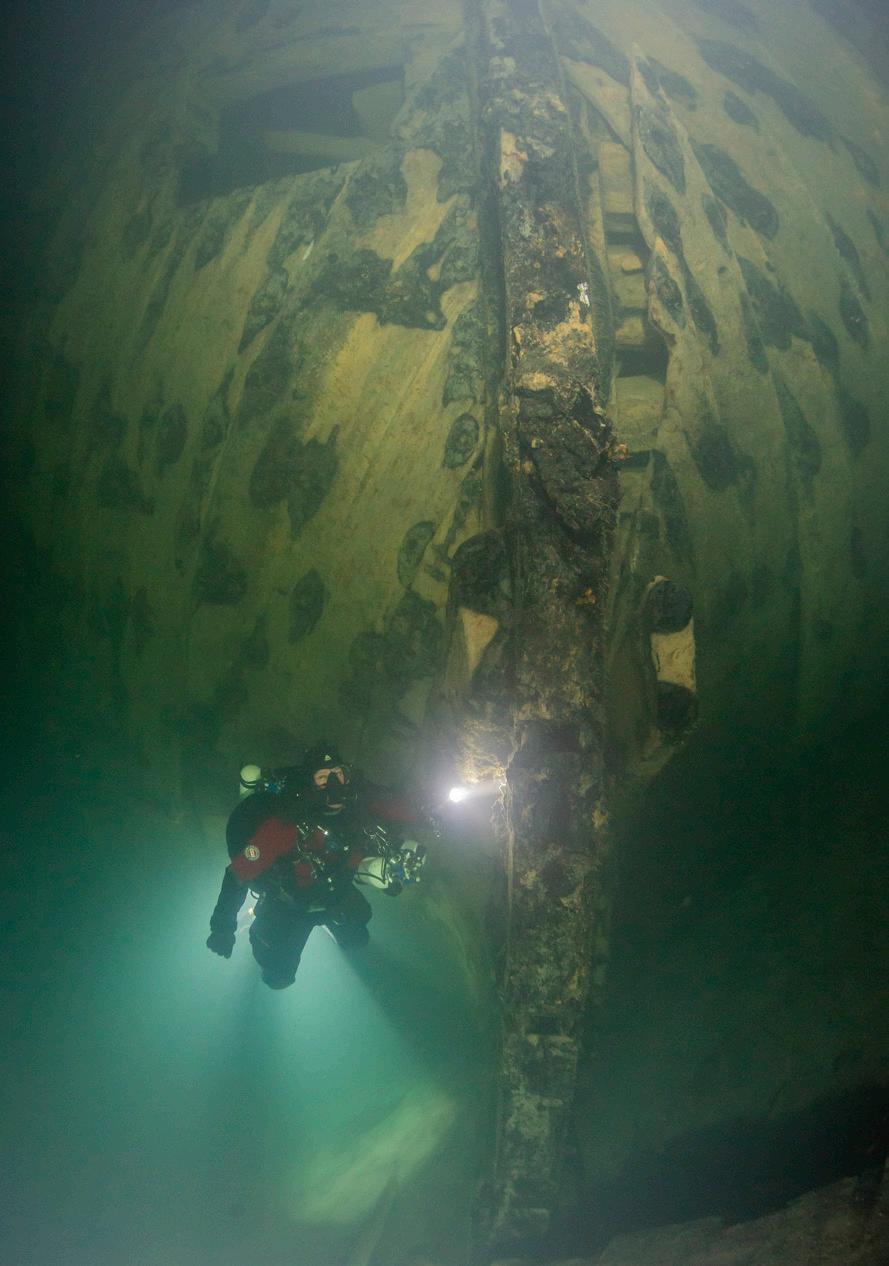
800 Swedish and 300 Danish/German soldiers and sailors go down with her.
Mars lands on the sea floor 72 metres below in the cold and dark Baltic Sea. And here she would probably still lie unnoticed, if it were not for a childhood dream in an exceptionally stubborn and persistent Swedish diver, many centuries later.
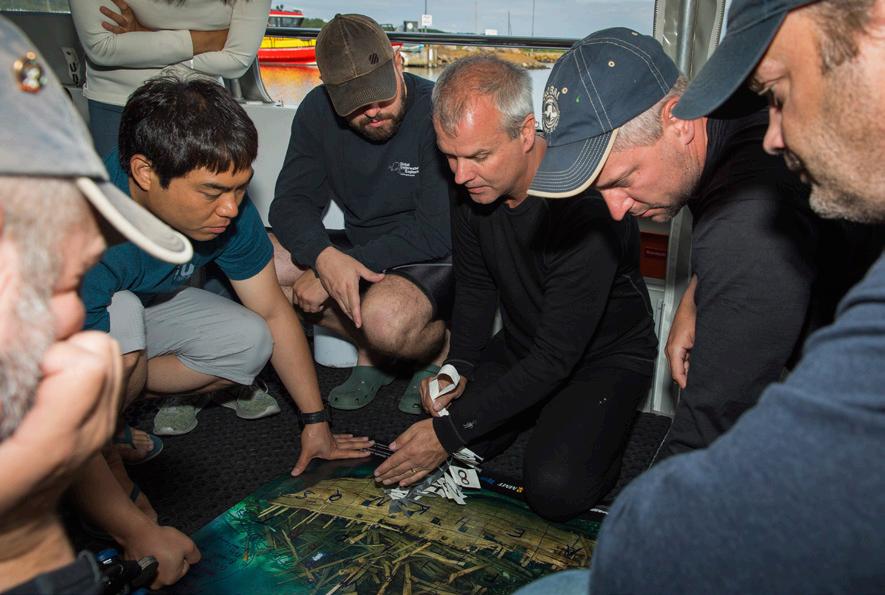
PART 2: 2011 – THE DISCOVERY In 1977 Siegfried Lundgren brought his three young sons to the Vasa Museum in Stockholm.The visit ignited a fire in the then eight-year-old Richard, and soon he and his brothers developed a passionate interest in exploring the wrecks of their native Baltic Sea. They already knew the legends of the Swedish amateur archaeologist Anders Franzén’s discovery of the royal ships of Vasa and Kronan, and they knew that Franzén had also been hunting for Mars and Svärdet (The Sword). They set out to do what Franzén had failed to do. They wanted to find Mars and The Sword!
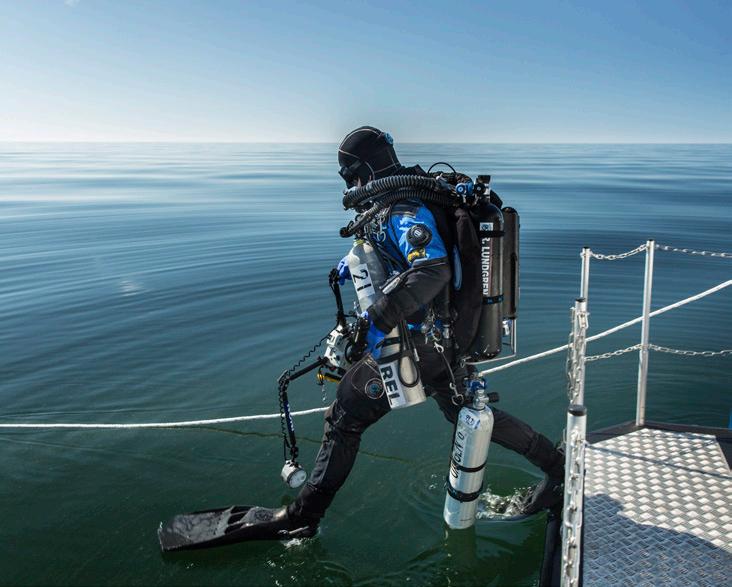
Richard remembers, “We started to evolve as wreck divers, and eventually the usual wrecks lost some oftheir appeal –we wanted to find something spectacular. We began searching for CF Liljevalch, a cargo vessel torpedoed during World War II. She had previously been found and lost again, but we rediscovered her and were able to explore her effectively for the first time, even though she was down at 70 metres, because in the meantime we had learned to dive with trimix. We were prepared to look for other, and even deeper wrecks.”
The three brothers and a shifting cast of like-minded advanced wreck divers started searching the northern tip of Öland as early as the 90s with the help of simple sonar equipment. In shor t, the ambition was to find and document as many wrecks as possible around Öland, but the principal goal was still to locate the legendary Mars Makalös and Svärdet. The group located and dived lots of wrecks.The highest record was finding six new wrecks all on the same day! But they never found what they were really looking for.
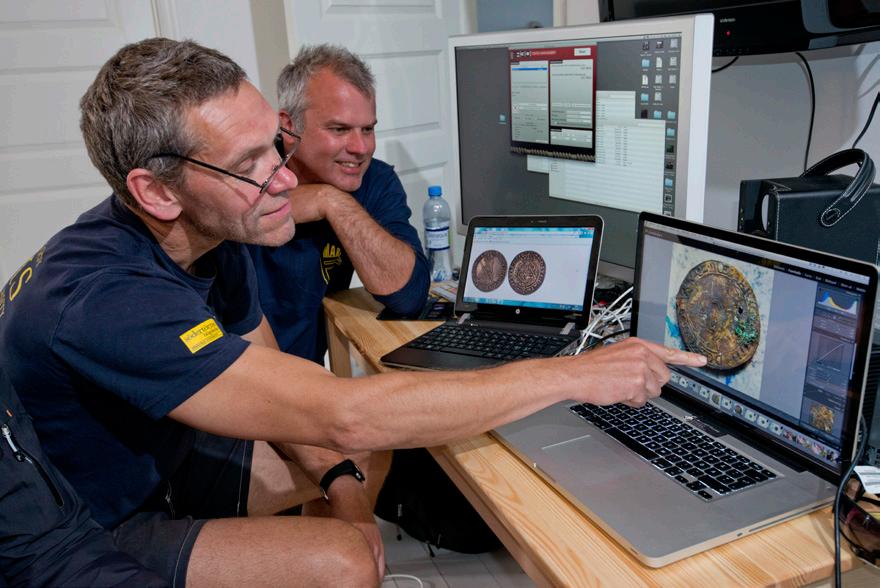
The divers soon became involved in other projects around the globe, making the search for the two proud ships more sporadic over the years. In the end, Richard was the only active diver left, but he never gave up hope on finding Mars.
“In 2010, we gained renewed motivation when a wealthy Swedish contractor invested in a new boat with modern search equipment for us. We could now be more efficient and focused. That year we located about ten new wrecks in the area off the west coast of Gotland. But we didn’t find what we were looking for. 2011 started off really well when we discovered new wrecks in an area that had supposedly already been searched. We could clearly see that our new gear provided more possibilities and greater precision”, says Richard.
JACKPOT! “Guys, check this out”, Christofer shouts. He has discovered something unusual on the screens showing the signal from the ship’s side scan sonar. It is a long time since the first time Christofer saw a wreck on the sonar screen, so it is surprising that he is so agitated. The team has been following a field of scattered debris for the past twelve hours, but can this really be the ultimate reward? Richard Lundgren need only take a quick look at the screen before he understands why Christofer sounds so excited.
The side scan image does not show an intact wreck, but rather a scattered wreckage with a complete, 40-metre-long hull side and lots of wreckage and ship details.

“What do you think?” Christofer asks.
“We got her! Finally, we have found her!” Richard shouts as he realises that this is a historic moment.

The team plans to dive the wreck to confirm the identity, but they already know that the most important wreck discovery of their generation is a reality. The broad smiles say it all.

FIRST MAN ON MARS Richard Lundgren clearly remembers the first dive. “Slowly the contours take the form of something big in the water as we sink down to 70 metres. It is dark and very cold. I’m shaking, but I can’t tell if that’s the cold or the anticipation? It has been a couple of weeks since we saw the exciting sonar image. It was absolutely insane – after 20 years of searching, we had to leave ground zero unprotected and without being able to publish what we had found. Imagine if anyone else stumbled upon Mars! It was a risky business.
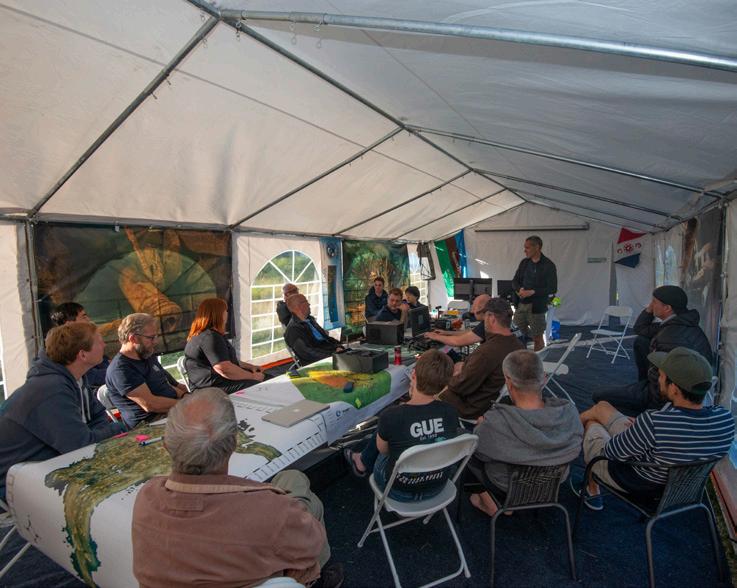
But now we’re here. Under the light of a powerful lamp, I see something big taking shape under me.These are definitely par ts of a wooden hull and soon we realise the size of the wreck –it’s huge! We’re the first to land on Mars, I think, and can’t help giggling into my regulator. In front of us we see an impressive hull side in solid oak, and as we continue forwards, rows of cannon potholes emerge in the dark. The ship’s planks have degraded over time, but it is still easy to get an impression of how powerful the ship once was.”
The team continues to swim toward what appears to be the stern, and they are amazed to discover what must have been Admiral Bagge’s quarters and they can actually swim into it.
Richard recalls, “We glide into the dark overhead, and I strive to absorb all possible impressions. Is Admiral Bagge’s famous treasure hidden here? The silver coins that the DanishLübeck attackers sought and the reason why they fought so fiercely. Did they seize the treasure or is it still on board? The historical documents provide no answers, but I have a feeling that future dives might solve the mystery. We continue the dive and go a little deeper.”
GUNS GALORE “As we approach the bottom, the visibility deteriorates from maybe 20 metres to just a few. We tighten up our formation and signal OK with our lights. In the murky visibility I spot something familiar and I swim closer to it. It’s a cannon! I can’t believe my eyes. It is a bronze cannon nearly five-metres-long.
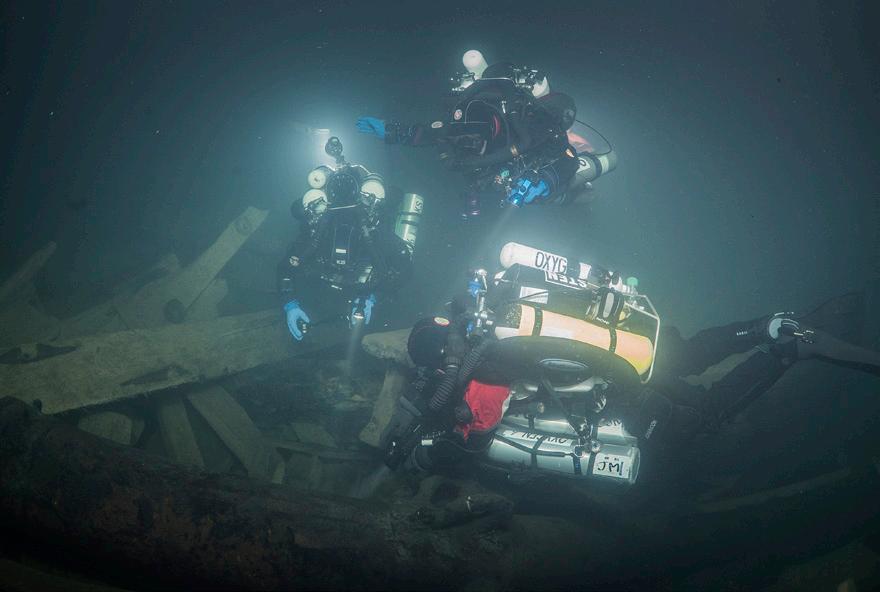
The ghostly green colour of oxidized metal is reflected in the light. “Cannon! Cannon!” I yell loudly in my mouthpiece. I hear echoes and it takes a few seconds before I realise that Fredrik is shouting exactly the same. As I turn to him, I understand why he is yelling and I can hardly comprehend what I am seeing. Fredrik has found a pile of no less than seven cannons, all in different sizes. The dimensions of the dolphin ornaments, the handles and the other details of the larger weapons are remarkable. This is better than what I imagined in my wildest dreams! Gently, I brush some sediment away from one of the cannons. The contours of a coat of arms becomes clearer. I have exposed what becomes indisputable evidence that this is indeed the Mars wreck. I have discovered King Gustav Vasa’s emblem – a crossbow made out of grain. This is for sure the wreck ofMars Makalös!”
After more than 20 years of searching and without ever giving up hope, Richard Lundgren and his team had finally found Mars and he had fulfilled his childhood dream. By the way, the Sword was found later that same year by a competing wreck hunting team, but that’s a story for another time.

PART 3: 2019 – TWO WEEKS ON MARS July 2019 is a wet, cold and windy affair on the Swedish Baltic Sea coast. The dive team arrives from different parts of the world over a few days and they immediately begin equipment preparations and set up the tent that makes up the Mars Expedition headquarters.
Gradually, the diving shed is also ready, the compressor is set up, the diluent-cylinders for our JJ-CCR rebreathers are filled with 12/65 trimix, the deco cylinders are labelled and a charging station for the huge amount of batteries needed to feed our lights, cameras and dry suit heating systems are set up. We are ready for the first Mars-dive of the year, but the weather forecast is not promising. The normal daily rhythm – an early morning dive and an afternoon spent preparing for the next day – is disrupted by the weather gods and we simply have to adopt a mindset of constant alertness and be ready to dive at short notice when a sufficiently promising weather window appears in the forecasts. Mars is situated 60 minutes east of the port of Böda at Öland and in a relatively exposed area. A typical Mars dive lasts up to three hours, and with one hour back and for th, we need a five-hour window with fairly calm winds.
The dive team consists of a dozen specially selected divers. Everyone is trained by Global Underwater Explorers on the JJ-CCR rebreathers The team is made up of divers with extensive project experience who can dive under difficult conditions while being productive, efficient and, above all, safe. Most are experienced underwater videographers or photographers.
GIANT MIKADO I had already been warned that the first dives on Mars can be somewhat confusing. And they are! I am overwhelmed by the grandeur and complex nature of the wreck. At this depth in the Baltic, it is always pitch black and you can only see what you can illuminate with your dive light. At first glance, the wreckage resembles a lumber yard gone berserk, or a giant game of Mikado. The cold Baltic at 4˚C, the darkness and the inevitable narcosis add to the challenge. Frankly, I’m a little intimidated by it all. After all, I am the rookie on the team and I would like to be able to contribute positively to this year’s expedition. Eventually, I start recognising details and after getting a few reference points, my situational awareness improves.
The wreck is spread out over 500 metres and it is actually possible to follow the last hours of the battle step by step following the tracks it has left on the seabed. Cannonballs, parts of the hull and masts, as well as personal artefacts, bear testimony to the brutality of the sea battle. The main wreck itself, including both hull sides, are relatively intact in the middle of the wreck area, where guns of various dimensions and calibres are sprinkled across the seabed in unprecedented quantity.
THE DEEP FREEZER After 40 minutes on the bottom, about two hours of decompression awaits. As soon as we rise just a few metres above the wreckage, the visibility suddenly becomes clear as gin. On the other hand, the temperature drops to just two degrees and we can only think about moving quickly through the freezer while spending as little time as possible on the deeper deco stops.
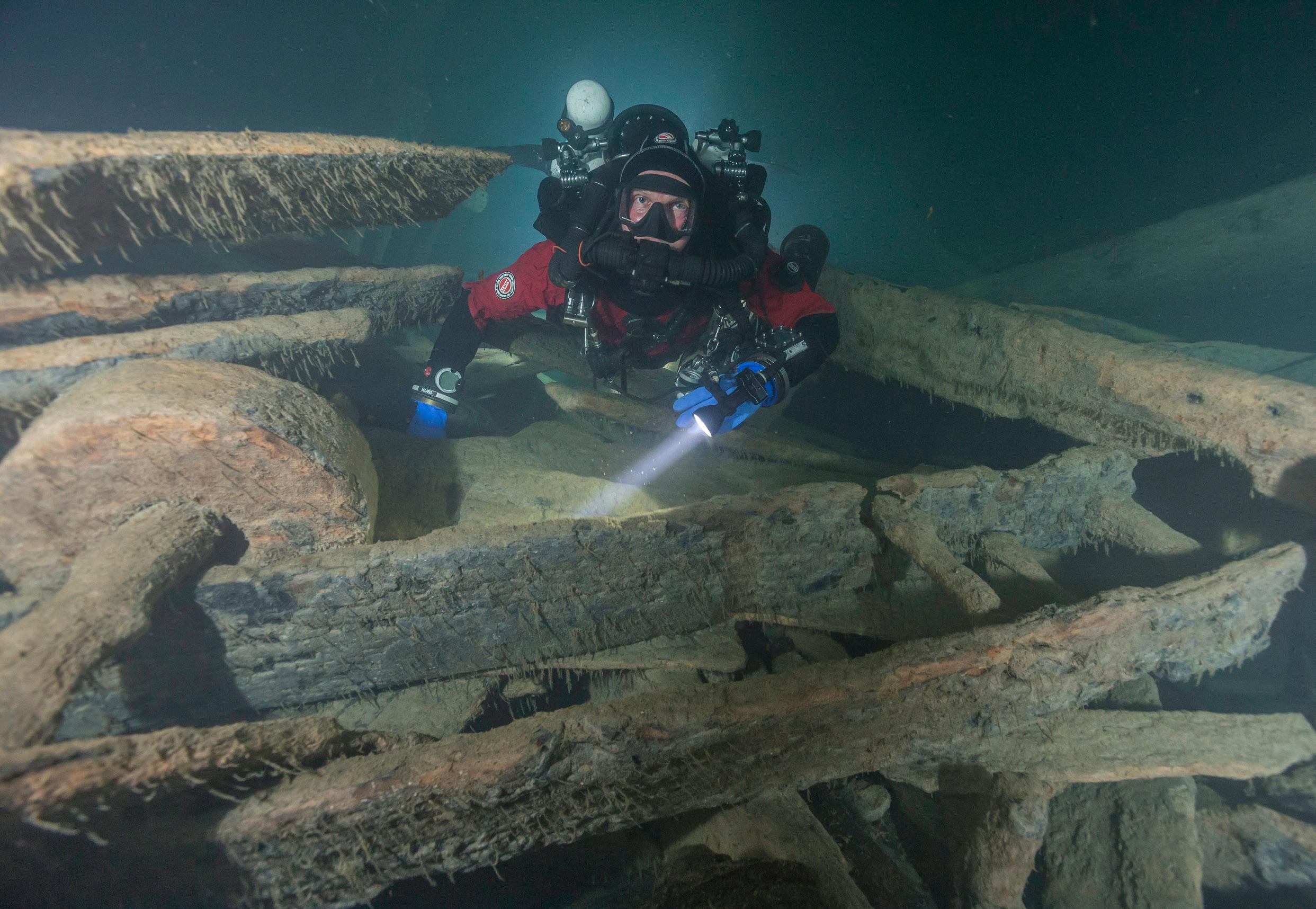
After the first hour in the water, the effect of our heated Santi-suits begins to wear off. There is still some juice in the battery pack, but the body has been cold for a long time. It can be hard to grasp the fact that there are still two hours of decompression time to go. Fortunately, the rebreather technology is on our side. On open scuba, you breathe cold, compressed gas, which is heated in the lungs and then exhaled directly into the water. It’s a big waste of heat energy. A rebreather diver, on the other hand, inhales his own warm exhalation gas, which has added heat energy from the process that takes place when the carbon dioxide in the exhalation gas is purified in the rebreather’s scrubber material.
Around 30 metres, the decompression stops begin to get longer and the temperature increases accordingly. On the last shallow stop, the visibility gets worse again and we move closer to the ascent line. It is important not to lose it and have to shoot a bag. The last stop at six metres lasts about an hour and I usually just try to turn my brain off and zone out while the minutes just tick away. Fortunately, the surface water is around 17-18˚C,but at this point we are all cold. However, it helps to visualise the barbecue that we will all get to enjoy in a few hours.
PHOTOGRAMMETRY After the discovery of Mars in 2011, a special law was quickly made to protect the wreck site. It is illegal and impossible to dive Mars without special permits, and the area is monitored 24/7 by the Swedish Coast Guard. It is prohibited to fish, stop or use sonar in a circular area within a diameter of 1 mile.
However, each year a special permit has been granted to a small select group of divers who, in collaboration with international and Swedish researchers and experts during the four teen days the permit lasts, conduct field studies at the unique archaeological site.
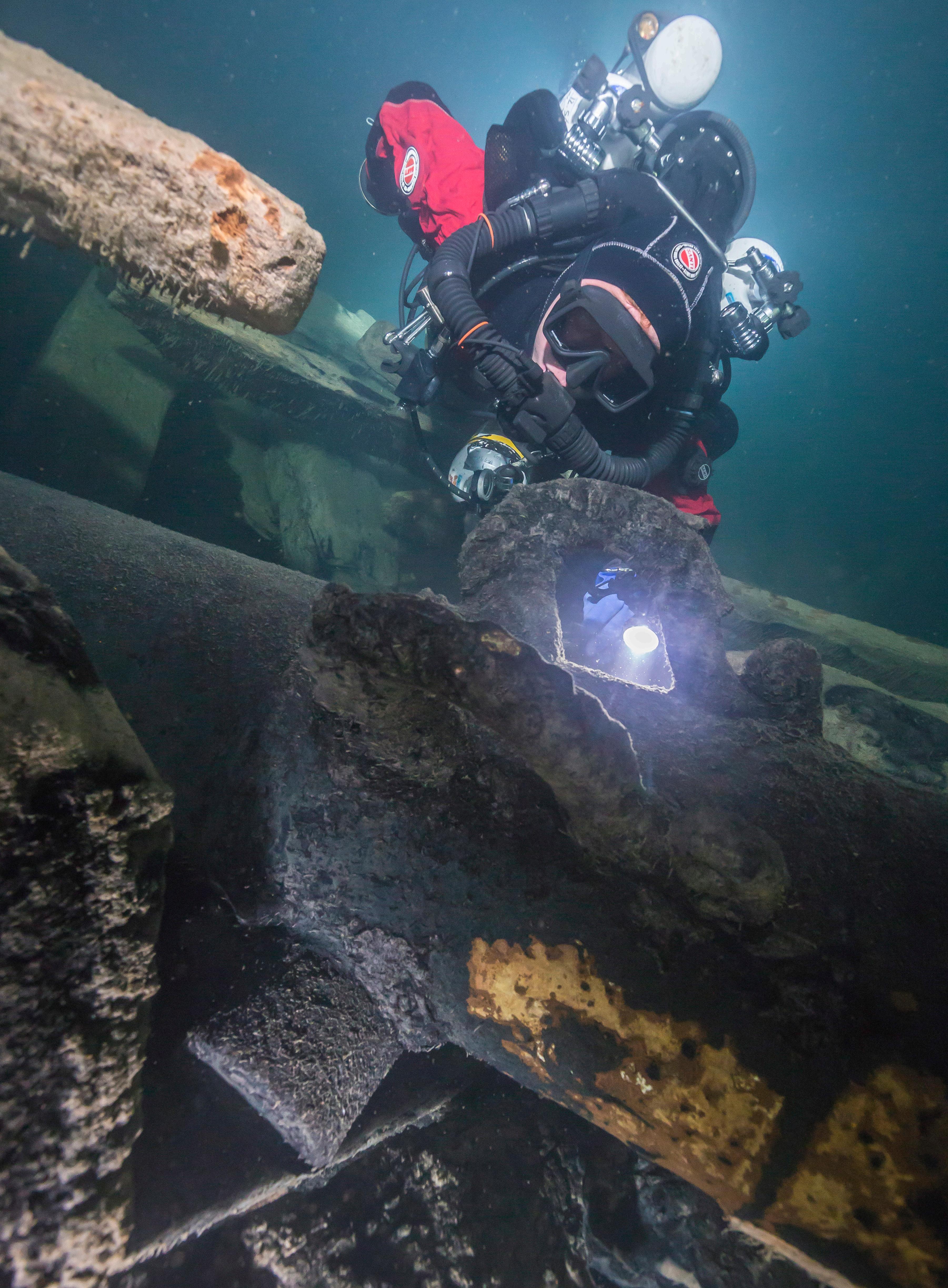
In the first few years, the main focus was to map the wreck site to get an overview. The iconic mosaic image, created from 640 images, which were painstakingly put together in Photoshop, went around the world and was on the cover of several magazines including National Geographic.
The mosaic assembly, which visualised Mars in a way no one would be able to see in reality, introduced a new approach to underwater archaeology. It was clear from the start that salvaging the wreck was out of the question. Bringing it on land and preserving it would be impossible and too costly. In addition, the oxygen-poor, brackish and ice-cold Baltic Sea at a depth of 72 metres is in fact the optimal place to store ancient woodwork. The absence of wood worms in the almost fresh water offers the best possible conditions.
Instead of salvaging objects from Mars, the Lundgren brothers and their team began developing and refining digital documentation techniques, such as 3D scanning and photogrammetry. The Mars exploration began parallel to the maturing of technologies that achieved a precision that supports serious scientific studies. But it is one thing to do photogrammetric documentation of smaller objects in the controlled environment of a photo studio, but something completely different to document large shipwrecks at 72 metre depths in pitch dark conditions. GUE divers are specialised in working efficiently with documentation methods and photogrammetry techniques are now part of the course curriculum.
DIGITAL EXCAVATION On the basis of the photogrammetric 3D models, the ship can be digitally rebuilt and the models provide a fantastic overview of the entire wreck site and allow researchers from all over the world to participate in the archaeology studies of this battlefield frozen in time. For example, an expert in 15th century weaponry can study the digital models and make measurements with centimetre accuracy. Scientists or experts can discover contexts or details that divers can’t see with the naked eye underwater. And the scientist can participate in the research without ever leaving their office. Photogrammetry also makes it possible to reconstruct or 3D-print artefacts such as small guns. Or make scale models of the entire wreck.
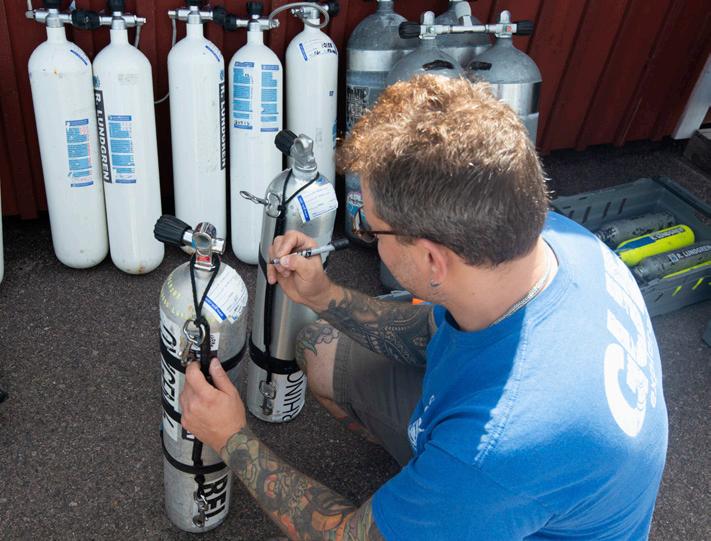
It has been claimed that Mars is one of the world’s most significant wreck finds and the series of parallel scientific projects focusing on many different aspects of Mars is proof of that. Life on a warship in the 16th century, shipbuilding techniques, metallurgy studies of cannons and the role of warships in society are just a few examples of these ongoing scientific projects. Mars sank with more than 800 soldiers and sailors on board. They have left many remains and artefacts that allow experts to reconstruct and describe life on board, thus providing an insight into life in the 16th century. Mars is an undisturbed time capsule that can provide many answers to an ever-growing number of questions.
NAT GEO We know that in a few days, our camp will get a visit from a British production team that is working on an episode for National Geographic’s series, Drain The Oceans. Although I usually take still photos while diving, I am tasked with recording video sequences on Mars that Nat Geo can use as material for the show.
Furthermore, I make photogrammetry recordings with macro lenses of, among other things, coins, a mold used to forge small cannonballs and details on bronze cannons.
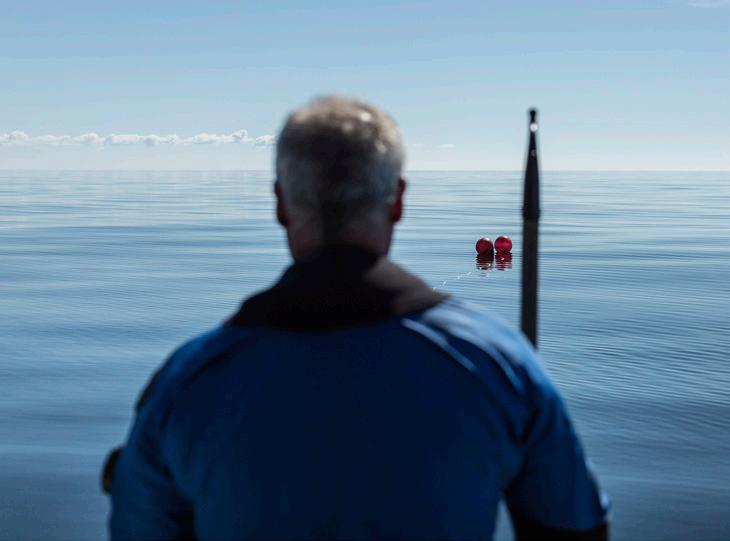
My images are used for photogrammetry renderings and these details have never been documented with such precision and resolution in 3D. Otherwise, the most important result of the 2019 expedition is the expansion of the mapped area around the wreck itself. Many more details are added, but much work remains to be done if we want to cover the entire fallout area around Mars, where numerous effects and their relative placement can provide important information to the researchers. If, at some point, it is decided to salvage more objects, it is also important to document their location and context before moving them. The mapping is done by a photogrammetry diver swimming steadily above the bottom and shooting multiple images with a certain overlap, which is then digitally assembled into a 3D model. But this laborious work could be done far more efficiently with a remote-controlled underwater video robot (ROV) that does not have to decompress after 30-40 minutes on the bottom. However, this is expensive equipment, but efforts are currently underway to obtain funding through sponsorships, so we divers can concentrate on more specialised tasks where it is advantageous to have a human in the water.
I look forward to being part of the team again in 2020, where we hope, among other things, to find answers to the question: where are the remains of the 800+ soldiers that perished in the wreck and where is the missing wreckage located?
DIVE TEAM: MARS 2019 Everyone in the dive team are GUE trained and have hundreds of hours of experience on the JJ-CCR in the GUE configuration:
• Kirill Egorov, Russia
• Jesper Kjøller, Denmark
• Kees Beemster Leverenz, USA
• John Kendall, UK
• Rachael Kendall, UK
• Oleksiy Sverdlov, Ukraine
• Marcus New, UK
• Su Eun Kim, Korea
• Kyungsoo Kim, Korea
• Richard Lundgren, Sweden
FACTS: GUE Global Underwater Explorers (GUE) was formed in 1998 by a small group of ambitious divers who strived to develop underwater projects that made it possible to explore underwater environments. From the beginning, GUE has been based on three pillars: Education, Exploration and Conservation. Today, GUE has a complete educational programme that covers all areas from the basic course GUE REC1 to instructor trainer. GUE appeals to divers who are prepared to go the extra mile in terms ofpersonal fitness and who generally have an uncompromising approach to diving.
GUE is based on a holistic system that was originally developed to meet the requirements of complex technical dives such as deep wreck dives or extensive cave exploration. But gradually the organisation adapted to include recreational diving in every conceivable environment. Although different dive situations require the addition of specific tools and techniques, there are a number of key components that ensure success and are the same on all platforms. Elements such as precision buoyancy, stability, standardised equipment, swimming techniques, teamwork and a thorough understanding of gas dynamics, are considered fundamental by GUE.
The comprehensive degree of standardisation and alignment of procedures, equipment configuration and dive planning make the GUE diveran extremely effective project participant, since everyone in a GUE project has the same approach to diving and has compatible configurations and procedures.
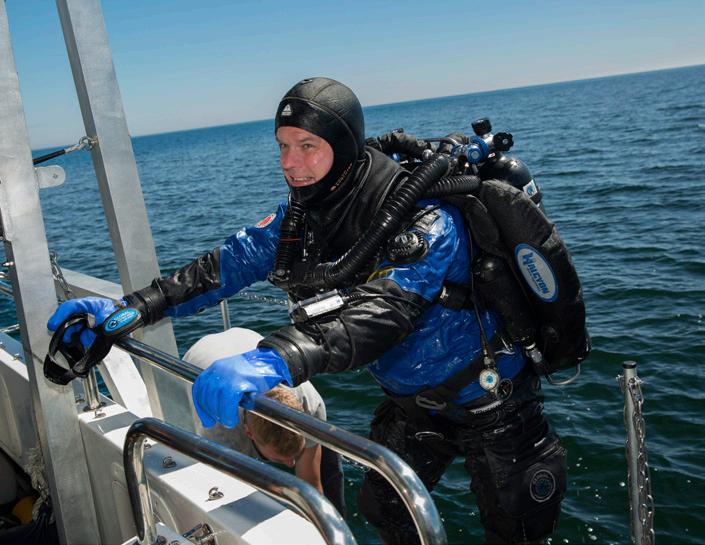
GUE’s standardised and holistic approach to scuba diving has proven its value and has thus accomplished some of the most ambitious and successful exploration projects of the past 20 years, including the discovery and ongoing exploration of Mars.
FACTS: EQUIPMENT All Mars divers use JJ-CCR rebreathers in the special GUE configuration. The major, compared to the standard unit, is that the GUE version has two seven-litre steel bottles connected with a flexible Lola-manifold. This means that the diver in the GUE configuration can carry a total of 14 litres of diluent compared to the standard three litres. The GUE diver therefore does not need to include a deep diluent gas as a separate bail-out as he has enough on his back. At the same time, there is enough gas to share with an unfortunate team member if need be.
Another difference is that the GUE configuration also features alonghose for open circuit gas sharing and the cylinders are turned upwards so valve shutdowns are done similar to open systems.
Everyone uses electric heated undergarments from Santi. At least a heated vest or a full suit, but most also have heating in their gloves.










